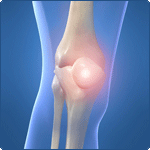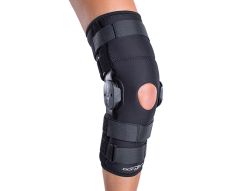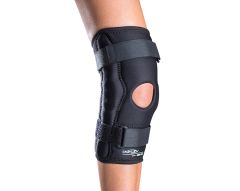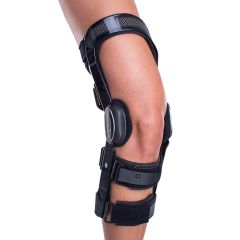
Hyperextended Knee
A hyperextended knee occurs when your knee is pushed past its normal range of motion from a straightened position. It is bent too far back in the wrong direction. Mild knee hyperextension may feel sore and uncomfortable and can typically heal with rest in 2-4 weeks. Serious knee hyperextension can cause damage to the anterior cruciate ligament (ACL) or posterior cruciate ligament (PCL) and cartilage injuries in the knee, which may require surgery. Consult your physician if you have a hyperextended knee injury. Your doctor will be able to advise you on the best treatment, benefits of using a knee brace, and may prescribe physical therapy exercises to help you heal quickly.
Learn More About a Hyperextended Knee Injury
- Causes of a Hyperextended Knee
- Symptoms of Knee Hyperextension
- Hyperextended Knee Treatment
- Knee Braces for Knee Hyperextension
Hyperextension typically occurs when the knee absorbs strong, sudden force while the leg is straightened. This can happen for a variety of reasons:
- During activities such as basketball or sports that involve a lot of jumping and changes in direction at high speeds
- During sports that revolve around flexibility such as gymnastics
- During a car accident when the knee is smashed
- Falling while the foot is caught
- Having weak quad muscles unable to support the knee
- Instability of the knee joint from previous ligament injuries
The most obvious symptom of knee hyperextension is pain behind the knee or on the sides. Patients will often hear or feel a pop at the time of injury. Swelling will usually start shortly after the time of injury, and the patient may have trouble walking, bending the knee, or continuing activity due to pain and instability
A visit to the doctor to ensure that the ligaments and cartilage in your knee are intact is recommended. For minor knee hyperextension, RICE (rest, ice, compression, and elevation) for 2-4 weeks will allow the knee enough time to heal. For more severe injuries which may include ligament or cartilage tears, recovery time estimates around 6-12 months post-surgery for the knee to resume full activity.
A knee brace can help support a hyperextended knee during recovery and prevent re-injury. Our brace experts recommend any hinged knee brace. These knee braces provide stability when moving and help absorb forces during sports and physical activity.
Weak surrounding leg muscles can place you at higher risk for knee hyperextension. A physical therapist may suggest different strengthening and stretching exercises to help build up the muscles around the knee.
Wearing a knee brace during sports or activity may help prevent a hyperextended knee. Supporting your hyperextended knee after injury is important for healing and preventing further hyperextension. Utilize a knee brace immediately after the injury for stability purposes. The following knee braces can help with the prevention and treatment of knee hyperextension.
For Mild Support and Compression: DonJoy Economy Hinged
For Lightweight, Powerful Protection: DonJoy Fullforce Knee Brace
For Mild to Moderate Support for ACL and PCL Instability (available as a sleeve or wraparound): DonJoy Playmaker or DonJoy Playmaker II
For Maximum Support: Bionic Knee
For Daily Wear: DonJoy Deluxe Hinged








